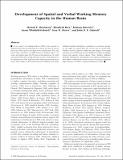Development of Spatial and Verbal Working Memory Capacity in the Human Brain
Author(s)
Thomason, Moriah E.; Race, Elizabeth; Burrows, Brittany; Glover, Gary H.; Gabrieli, John D. E.; Gabrieli, Susan; ... Show more Show less
DownloadThomason-2009-Development of Spatial and Verbal Working Memory Capacity in the Human Brain.pdf (613.7Kb)
PUBLISHER_POLICY
Publisher Policy
Article is made available in accordance with the publisher's policy and may be subject to US copyright law. Please refer to the publisher's site for terms of use.
Terms of use
Metadata
Show full item recordAbstract
A core aspect of working memory (WM) is the capacity to maintain goal-relevant information in mind, but little is known about how this capacity develops in the human brain. We compared brain activation, via fMRI, between children (ages 7–12 years) and adults (ages 20–29 years) performing tests of verbal and spatial WM with varying amounts (loads) of information to be maintained in WM. Children made disproportionately more errors than adults as WM load increased. Children and adults exhibited similar hemispheric asymmetry in activation, greater on the right for spatial WM and on the left for verbal WM. Children, however, failed to exhibit the same degree of increasing activation across WM loads as was exhibited by adults in multiple frontal and parietal cortical regions. Thus, children exhibited adult-like hemispheric specialization, but appeared immature in their ability to marshal the neural resources necessary to maintain large amounts of verbal or spatial information in WM.
Date issued
2010-05Department
Massachusetts Institute of Technology. Department of Brain and Cognitive SciencesJournal
Journal of Cognitive Neuroscience
Publisher
MIT Press Journals
Citation
Thomason, Moriah E. et al. “Development of Spatial and Verbal Working Memory Capacity in the Human Brain.” Journal of Cognitive Neuroscience 21.2 (2009): 316-332. © 2009 Massachusetts Institute of Technology
Version: Final published version
ISSN
0898-929X
1530-8898